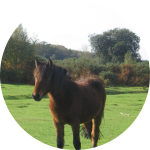|
Few animals have influenced the history of human culture
like the horse. These four-legged running machines gave us
food, mobility, and enhanced success at hunting hard-to-catch
animals. And the influence goes both ways: archaeologists
say that horse skeletons dating from 2000-2500 BCE already
show differences from those of wild horses that attest to
the effects of breeding and (partial) domestication, while
scientists theorize that the adoption of horses by Late Ice
Age-era Eurasian tribes may well have saved these horses the
extinction that befell their North American counterparts.
But with all else they've given us, horses have symbolized
grace and power for thousands of years. Paleolithic cave art
is some of the oldest known art on earth; what inspires awe,
however, is - bluntly - that it's as great as it is old. Here
at the dawn of art history we find images of animals so subtle
in their artistry, in the mixing of the colors and in their
observed details, and yet so grand in size and conception
that they still transfix observers today.
The Lascaux cave paintings of southwestern France, near the
village of Montignac, represent the most famous examples of
this branch of art. Discovered in September 1940 by four French
teenagers and a dog, these caves hold nearly 2000 figures,
including animals (an estimated 900, of which 605 have been
identified), some faint dot configurations which may represent
constellations, and a single human.
The caves' bison paintings may rank among its most famous
- one bison is 17 feet long, while another, "The Crossed Bison,"
shows a use of perspective that doesn't recur in painting
again until the 15th century CE - but a visitor to Lascaux
would see more horses than any other kind of animal: 364,
in fact.
"Would see" because the caves were closed to the public in
1963 after twenty-three years of tourism left the paintings
visibly damaged by carbon dioxide. However, the images can
be easily found in books and on the Internet, while tourists
to France can visit Lascaux II, a replica of two cave halls
that opened in 1983.
Horses rear their powerful heads in much of ancient culture
and literature; references to horseback riding appear, for
example, in Mesopotamian documents that represent some of
the earliest written remains of human culture. But no one
could forget the myth of the Trojan Horse - the gigantic horse
replica wrought by Epeius and presented as a peace offering
to the unfortunate Trojans, who didn't realize this "gift"
was stuffed to its pointy ears with heavily-armed Greek warriors
determined to end the ten-year Trojan War with a sneak attack.
The origins of this myth, as with the larger narrative of
the Trojan War, are shrouded in mystery, though it's possible
that they reflect at least some genuine history. (Some modern
commentators suggest that the Greeks might simply have made
a horse-shaped battering ram, and that the story of the giant
hollow horse arose from later oral historians' misunderstanding
of surviving veterans' descriptions of a "horse."
Ancient Assyrians, after all, often gave animal names to their
siege machines.) In any case, the story comes down to us from
a brief vignette in Homer's Odyssey (the hero of which, Odysseus,
came up with the scheme in the first place), and, most of
all, from Virgil's achingly vivid depiction in Book II of
his Aeneid. Here we learn of Laocoon's brave effort to warn
his fellow Trojans - "Don't trust this 'horse,' Trojans! Whatever
it is, I fear even gift-bearing Greeks" - and the midnight
raid on Troy, from which Aeneas, the mythical founder of Rome,
escapes with his life (but not, alas, his wife).
Among ancient painters of horses, the Tang Dynasty artist
Han Gan deserves special praise. Hailing from Chang'an (the
province of China we now know as Xi'an), or perhaps Shaanxi
or Henan - accounts differ - the young painter came to the
attention of the great Buddhist poet Wang Wei, who, like a
modern-day Guggenheim Foundation or National Endowment For
the Humanities, paid for Han's education.
He became a painter in the Han court, working with many subjects;
however, he's most famous for his paintings of horses. His
reputed ability to paint not only the body, but the spirit
of a horse earned him the privilege of painting the Emperor
Xuanzong's favorite horse, "Night-Shining White," among many
others.
Finally, horses recur in Norse mythology, where they are as
closely associated with particular gods and heroes as Silver
with the Lone Ranger. There's Heimdallr and Gulltoppr, Odin
and eight-legged Sleipnir. Little wonder, then, that horse
racing is viewed, from time immemorial, as the "sport of kings."
About the Author
TRP Services
offers Thoroughbred horse racing and horse racing tips online
for horse racing handicapping and those who love thoroughbred
horses for the horse racing tracks.
|


